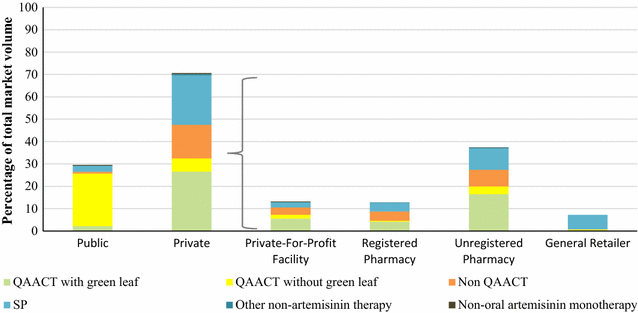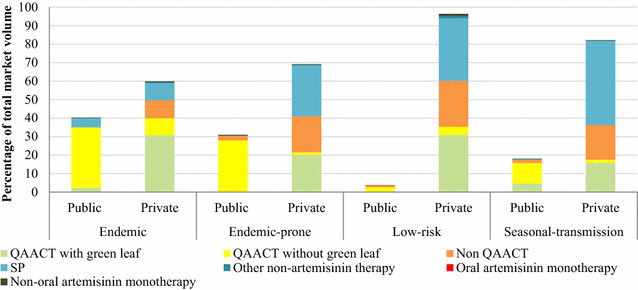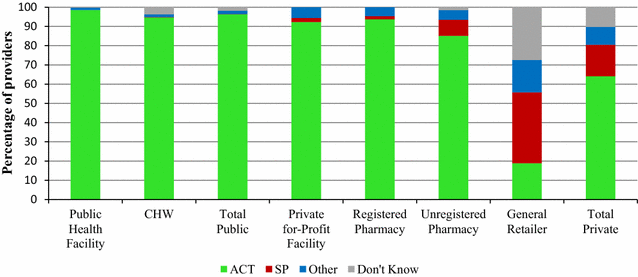The malaria testing and treatment landscape in Kenya: results from a nationally representative survey among the public and private sector in 2016
- PMID: 29268789
- PMCID: PMC5740898
- DOI: 10.1186/s12936-017-2089-0
The malaria testing and treatment landscape in Kenya: results from a nationally representative survey among the public and private sector in 2016
Abstract
Background: Since 2004, Kenya's national malaria treatment guidelines have stipulated artemisinin-based combination therapy (ACT) as first-line treatment for uncomplicated malaria, and since 2014, confirmatory diagnosis of malaria in all cases before treatment has been recommended. A number of strategies to support national guidelines have been implemented in the public and private sectors in recent years. A nationally-representative malaria outlet survey, implemented across four epidemiological zones, was conducted between June and August 2016 to provide practical evidence to inform strategies and policies in Kenya towards achieving national malaria control goals.
Results: A total of 17,852 outlets were screened and 2271 outlets were eligible and interviewed. 78.3% of all screened public health facilities stocked both malaria diagnostic testing and quality-assured ACT (QAACT). Sulfadoxine-pyrimethamine (SP) for intermittent preventive treatment in pregnancy was available in 70% of public health facilities in endemic areas where it is recommended for treatment. SP was rarely found in the public sector outside of the endemic areas (< 0.5%). The anti-malaria stocking private sector had lower levels of QAACT (46.7%) and malaria blood testing (20.8%) availability but accounted for majority of anti-malarial distribution (70.6% of the national market share). More than 40% of anti-malarials were distributed by unregistered pharmacies (37.3%) and general retailers (7.1%). QAACT accounted for 58.2% of the total anti-malarial market share, while market share for non-QAACT was 15.8% and for SP, 24.8%. In endemic areas, 74.9% of anti-malarials distributed were QAACT. Elsewhere, QAACT market share was 49.4% in the endemic-prone areas, 33.2% in seasonal-transmission areas and 37.9% in low-risk areas.
Conclusion: Although public sector availability of QAACT and malaria diagnosis is relatively high, there is a gap in availability of both testing and treatment that must be addressed. The private sector in Kenya, where the majority of anti-malarials are distributed, is also critical for achieving universal coverage with appropriate malaria case management. There is need for a renewed commitment and effective strategies to ensure access to affordable QAACT and confirmatory testing in the private sector, and should consider how to address malaria case management among informal providers responsible for a substantial proportion of the anti-malarial market share.
Keywords: ACT; Anti-malarial; Kenya; Malaria control case management; Malaria diagnosis; Private sector; Public sector.
Figures
References
-
- WHO. World Malaria Report. Geneva, Swizterland, World Health Organization; 2016. http://www.who.int/malaria/publications/world-malaria-report-2016/report.... Accessed 10 June 2017.
-
- Division of Malaria Control . Kenya annual malaria report 2012/2013. Nairobi: Ministry of Public Health and Sanitation; 2013.
-
- National Malaria Control Programme (NMCP) and ICF International. Kenya Malaria Indicator Survey. 2015.
-
- President’s Malaria Initiative. Malaria Operational Plan FY 2016. 2016. https://www.pmi.gov/docs/default-source/default-document-library/malaria.... Accessed 24 Oct 2017.
Publication types
MeSH terms
Substances
Associated data
LinkOut - more resources
Full Text Sources
Other Literature Sources
Medical
Miscellaneous





